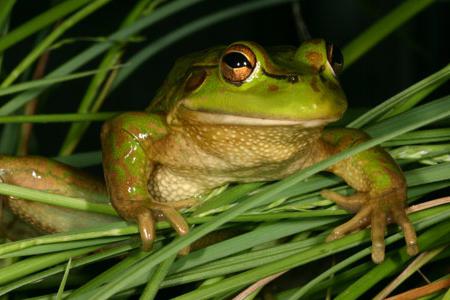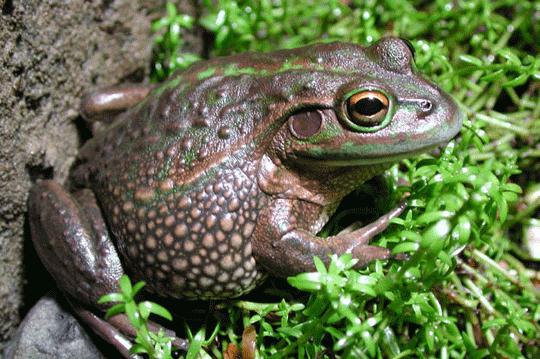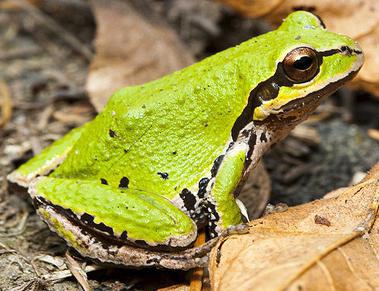Rana temporaria - amphibian class, genus and familyfrog squad tailless. Translated into Russian - grass frog. Habitat - steppe, forest-steppe, coast of reservoirs, forests, wet swampy places. The life span of an amphibian is long enough, in nature - about 5 years, in captivity - it can reach 15-18 years.

Common frog: description
There are three subspecies of the grass frog:Rana temporaria parvipalmata, Rana temporaria honnorati, Rana temporaria temporaria. They differ only in habitats and color. The grass frog has a squat body, the length of which can reach 10 cm. The average weight of an amphibian is about 22.5 g. Of course, there are also larger individuals that weigh up to 30 g, but in nature they are a rarity. The color of the backrest varies depending on the habitat. From above the grass frog can be gray, olive or reddish-brick shade. A distinctive feature of an amphibian is a well-defined dark brown triangle near the eardrum. On the sides and back of the frog there are small (1-3 mm) dark spots. There is a marble-like pattern on the dark abdomen. The grass frog, as a rule, has brown eyes with black horizontal pupils of the eye, however, there are albino specimens with red eyes. During the mating period, males acquire a lighter color, while females, on the contrary, become darker. Amphibian skin is smooth, slightly slippery, the epidermis does not keratinize.

Behavior in nature
The most active frog is grassdifferent in the evening and at night. Daytime activity can occur only in cloudy weather or in damp, shady places. On a sunny day, a frog hides under stones, in dense vegetation, in stumps. With the onset of cold weather, when the air temperature drops below 60 C, activity ceases.Winter frogs are sent in large groups, the number of which is from a few dozen to hundreds. They select places for wintering scrupulously. As a rule, these are non-freezing rivers with a muddy bottom, roadside grooves or wetlands. The group tries to overcome the distance to the wintering site in one day, usually it is no more than one and a half kilometers from the summer habitat. If conditions of hibernation deteriorate, the group leaves the selected area, selecting a more suitable place.

Young frogs are sent for wintering laterSome of them can be found even in November. During the hibernation period, the frogs are sitting on their hind legs, they cover their heads with their front legs and twist their palms up. The hibernation period lasts about 155 days. At this time, the frogs go on skin respiration. If the reservoir selected as a wintering site freezes to the bottom, then the whole group may die.
Food
Many amphibian lovers are interested in whatthe grass frog eats. Favorite delicacy of adult individuals - flies, slugs, dragonflies, midges, snails. They hunt them with a sticky long tongue. Tadpoles mostly prefer plant food. They feed on detritus, algae. During the mating season, the frog does not eat.
Reproduction
Sexually mature frogs become 3 years old.Reproduction can occur in any shallow body of water: in puddles, ditches, lakes. Spawning begins 3-5 days after hibernation, in April-May. Males come to the reservoir earlier. Partners, they tout with the help of marriage "songs." The frogs begin to mate on the way to the spawning grounds. At this time, all the eggs of the females are ovulated and located in the thin-walled, stretched oviduct section, ready for laying. After spawning, females leave the spawning site. The laying of the frog is a clump of densely stuck shells. One individual lays 650-1400 eggs.

Enemies
Caviar frogs eat many birds, for example:mallard, newt ordinary, large spindle, puff, black tern, gray duck. Tadpoles are hunted by the white-browed thrush, the magpie, the swimming beetle, the roller bug, the blackbird thrush. Adults feed on the black stork, Gray Shrike, Rough-legged Owl, Owl, Viper, Goshawk, Gull, Spotted Eagle, Shrike. In the springtime wolves may eat frogs.
Grass frog: maintenance and care
For keeping grass frogs at homeconditions recommended to buy a sufficiently large aquaterrarium (at least 30 liters). If this is not possible, you can buy a regular aquarium, which is filled with water, but put in it wood or foam, which will stay on the surface. This is done so that the animal can spend part of the time out of the water. It is advisable to squander the leaves or stems of any aquatic vegetation on these "islands of land" so that the frog can hide from the light. At the bottom of the aquarium also need to put aquatic vegetation. Since in nature the frog is not too demanding to the place of residence, it is quite simple to keep it in captivity. The water in the aquarium can be changed once a week to 1/3, but only once a month completely. Additional lighting or heating is also not required. You can feed your pet at home with cockroaches, flies, crickets, bloodworms, and a shredder. From time to time a frog can be given small pieces of raw meat. Young individuals are fed on lettuce leaves or nettle leaves with scalded boiling water.

Population status
Many factors cause the death of frogs.These primarily include: pollution of water bodies with harmful substances and household waste, heavy traffic. In addition, a huge number of frogs are caught annually for laboratory experiments and for lovers of terrariums. The destruction of forests, industrial pollution of the environment have led to the fact that in some places the frogs have completely disappeared.












